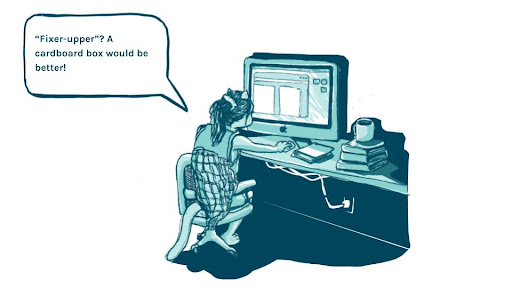Written by Copycat Staff
May 8th, 2022
Do You Need a Real Estate Listing Copywriter?

Do You Need a Real Estate Listing Copywriter?
Copywriting for real estate is a lot like cooking.
No, we’re not just referring to the gorgeous kitchens, waterfall countertops, and steam ovens of the homes on the market these days. We mean actual cooking.
A real estate listing is made up of key ingredients, and without the perfect balance of elements, you might find yourself without the hungry customers—aka, prospective buyers—you expected to show up.
As the seller or agent for a property, you could find a recipe that tells you exactly what to include. But if you’ve ever attempted to make something from scratch for the first time ever, you might know how things don’t always go as planned. (Like that time you accidentally added 1 T of cayenne instead of 1 tsp… no, just me?)
Rather than putting together a piecemeal recipe, a copywriter can serve as your real estate listing’s personal chef—intuitively combining the components that highlight every flavor and feature of the property you’re selling.
The Right Recipe: Why Copywriting Matters for Real Estate Listings
So, why does it matter that your real estate listings have flavor, spice, and texture? In truth, it’s all about where prospective buyers are looking for them.
In recent surveys of the real estate market regarding residential buyers, researchers found that:
- 97% of home buyers use the internet to search for homes
- 51% of buyers actually find the home they buy on the internet—more than any other source
- 86% of prospective buyers considered the online descriptions and details in listings to be one of the most useful parts of the listing, second only to photos
In other words, those searching for a property seem to rely heavily on the listings they find online—and just like you need the appropriate amounts of basil, garlic, parmesan, and pine nuts to make a perfect pesto, you need the right words in your real estate listing.
The Irresistible Aroma of Keywords
Have you ever seen one of those cartoons where the tantalizing scent of a meal reaches out to physically beckon the main character? The words in your real estate listing can summon just as much interest—but not just any words will do.
According to Zillow Listings and Sales data, using keywords to highlight certain features of a home can actually help it sell for a higher price and reduce the time it takes to sell.
Which words, you ask? They might not be the ones you expect. Those which contribute to higher prices and faster sales seem to call out a home’s most unique features rather than the biggest ones.
A few examples of those keywords include:
- Professional appliance
- Shed/garage studio
- Prep sink
- Steam shower
- Subway tile
- Exposed brick
Of course, you should only use keywords that represent actual features of the home. But knowing what features to highlight can make a difference. In the same way, knowing how to maximize your SEO potential by stirring the relevant keywords seamlessly into your listing can help bring more prospective buyers to your listing.
Some Words Help Less than Others
If you’ve ever created the perfect tower of beautiful golden pancakes, doused them in maple syrup, taken a big bite, and then gulped down a big sip of orange juice, you know that some flavors just weren’t meant to be together. In the same way that OJ makes a less pleasant pancake-pairing than milk, some words can unexpectedly sour the contents of your listing.
Using positive language and wording to describe features can have a sizable impact—but the words buyers might see as “negative” can be surprising, too. Data from Zillow shows that certain words can serve as red flags to buyers:
- Cosmetic
- Investment
- Fixer
- TLC
- Opportunity
- Potential
Although these words have good intentions—i.e., helping the prospective buyer see the silver lining in a potentially less-than-perfect property—the research shows that readers can see right through this coded language. So, what should you do instead?
The key here is to use words that truthfully but creatively help the reader imagine the possibilities and see the benefits lying within.

Storytelling Sweetens the Deal
An effective real estate listing should include all the details the reader needs to know to determine whether the property is the right fit. But aside from the basic facts like square footage and bathroom size, there’s something else that can make your real estate listings even sweeter—something a good copywriter knows like the back of their hand:
A generous spoonful of storytelling.
When you carefully fold in a narrative, your listing no longer just informs. Instead, it helps the prospective buyer envision their future within the property you’re selling. It’s like the difference between an unseasoned piece of chicken and your grandmother’s famous tangy, tomato-y, fine-tuned chicken cacciatore.
The copy for a real estate listing should do far more than list the facts. In fact, it serves as the very first taste your prospective buyers will get of the property.
A Case Study in Storytelling
To give you an idea of how much a narrative can help your listing, consider a listing that contains almost no storytelling at all:
This 10 bedroom, 10.5 bathroom house has spacious living and sitting areas featuring exposed wood accents and original stone floors. The large kitchen features oversized windows and opens into a small dining room. The second formal dining room in the rear of the kitchen seats 20. The home’s bedrooms feature vaulted ceilings and offer nice views of the rustic scenery.
If you read this description, you probably have an understanding of the basic components of this house—and it’s a pretty spacious one, to be sure. But would you know that it describes the very same house Diane Lane’s character renovated in the 2003 movie Under the Tuscan Sun?
We couldn’t blame you for saying no. While this description does include some important details, there’s much more we can add to the rich, seasoned history of the home.
Now, let’s look at how Architectural Digest described the same home when it opened for public rentals in 2018:
Fans of the film will remember the home's stone walls giving it a fairy-tale castle vibe, but the open, sun-drenched living spaces give it a bright and airy feel. The many, many windows also provide a stunning view of the Tuscan countryside worthy of Hollywood screen time. And crystal chandeliers add an element of glamour to the rustic, wood-beamed ceilings, while the stone floors round out the look. The kitchen is completely modernized, and laid out around a central island — the perfect place to nibble on some pre-pasta antipasto in the evening.
Granted, the quoted text above isn’t from an actual listing, but it contains all the storytelling you could hope to accomplish in one. The windows aren’t just oversized—they drench the living spaces in sunlight. The scenery isn’t just rustic—It’s “a stunning view of the Tuscany countryside.”
Aside from the story of the home itself, however, this description does another very important job: It invites the reader to envision themselves within it, lounging in the kitchen and enjoying the savory flavors of antipasto and all the history the house contains.
Structure Makes the Listing Sizzle
A close relative of this blog’s writer once attempted to make meatloaf in the crockpot.
Let’s be up-front—this meatloaf is a beloved family recipe. Everyone longingly anticipates the meatloaf as it bakes in the oven. It’s a dish you look forward to the entire time it bakes, one that has people fighting over the leftovers. In its usual execution, it’s a savory, mouthwatering work of art.
But this slow-cooked experiment had a fatal flaw that (as the chef readily admitted) rendered the dish inedible: without the intense sizzling heat of the oven, it lost all its structure.
The way you put together words can affect your real estate listing’s structure and readability just as much. It might be easy to think of a real estate listing as one big chunk of words necessary to list all the bells and whistles the property has to offer. But in reality (and realty) there are several different parts of a listing’s description—and each has its own significance to the reader.
Let’s take a tour through the parts of a real estate listing:
- Headline – These may be the first words your prospective buyer sees before seeing your listing—and could be the reason they click on it at all. Your headline should compel, add value, and draw people in.
- Opening paragraph – The next part of your real estate listing must set the tone for everything that follows. It needs to speak directly to the reader and inspire them to keep reading with promises of all the incredible features to come.
- Property description – The actual property description comes next—but as you’ve seen above, this is far more than a list of rooms and square footage. To capture the reader’s imagination, you need specificity, compelling adjectives, and a narrative that allows them to imagine their place in this property.
- Features – Whether you opt for an easily skimmable bullet list or a captivating summary of the property’s amenities, the words you use here make a difference. Any features you highlight should not only include the specs but also explain why the reader should care about them.
A copywriter attuned to the nuances of a real estate listing’s structure can transform an inedible mush of words into a perfectly tender, artfully roasted dish that leaves everyone at the table wanting more—and has buyers knocking at the door.
To Inspire More Moves, Create Moving Copy with Copycat
Now you know what it takes to add flavor and spice to your real estate listings. But do you really need a real estate listing copywriter to do it?
You could start watching reruns of Top Chef to build your culinary intuition and try to apply that knowledge to create delectable real estate listings. Or you could hire your own real estate copywriter who already has a taste for the keywords, structure, and storytelling your listings need.
At Copycat Copywriters, we have just the ingredients to make any listing sizzle. We believe storytelling is the secret recipe to any outstanding piece of copy—from real estate listings to websites and blogs.
Want to stir up some incredible listings together? We’ll grab our spoon.
Sources:
National Association of Realtors Research Group. Real Estate in a Digital Age. https://cdn.nar.realtor/sites/default/files/documents/2021-real-estate-in-a-digital-age-10-05-2021.pdf
National Association of Realtors. Quick Real Estate Statistics. https://www.nar.realtor/research-and-statistics/quick-real-estate-statistics
Zillow Research. Listing Features That Sell: If You've Got These, Flaunt Them. https://www.zillow.com/research/listing-features-that-sell-23814/
Zillow. Talk Ain't Cheap: 9 Listing Keywords That Could Cost You. https://www.zillow.com/blog/9-listing-words-that-could-cost-you-170940/
Architectural Digest. Villa From Under the Tuscan Sun Now Available for Public to Rent. https://www.architecturaldigest.com/story/villa-under-the-tuscan-sun-available-rent